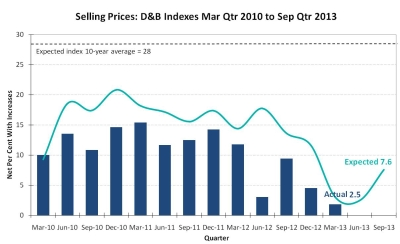After their expectations reached a 24-year low in the previous quarter, businesses are indicating that price rises are on the agenda in the new financial year as they seek to retain profits while compensating for cost pressures and low sales growth.
Despite a generally soft business outlook for the September quarter, Dun & Bradstreet’s National Business Expectations Survey has found that more businesses plan to raise the prices of their products compared to the previous quarter. The survey’s selling price index has lifted to 7.6 points, an increase from 2.5 in the second quarter of 2013 which was the lowest level of the index in nearly a quarter of a century.
With an increase in prices planned, businesses have also raised their profit outlook for the quarter ahead. As businesses struggle with high operational costs and sluggish sales activity, the move in the price and profit indices suggests businesses will target greater margins in response to a slow cash flow cycle.
The increased expectations come as the Australian dollar continues to weaken, with the currency hitting a 19-month low last week. The strength of the dollar through 2012 and early 2013 impacted the profitability of many businesses, with manufacturers, exporters and retailers in particular pushed to compete on price. Following the recent easing in the currency, D&B has found that 58 per cent of businesses expect that the level of the dollar will have no impact on their Q3 operations.

Despite the recovering outlook for prices and profits, expectations for capital investment, employment and sales have moved lower.
The sales expectations index for the September quarter has slipped below its 10-year average of 11 points, easing from 13.5 to 9.2. This declining forecast suggests that businesses anticipate higher prices will impact their sales levels, but may be looking to move beyond the recent trend of continual discounting.
“For some time now we’ve been hearing the phrase ‘discounting is the new norm’,” said Gareth Jones, CEO of Dun & Bradstreet.
“These latest findings, while tentative and initial, suggest that businesses may now be ready to move out of that mode,” he said. “Discounting is a well-established sales tactic – one that Australia’s large body of cautious consumers has no doubt welcomed in the post-GFC environment – however there’s a limit for all businesses to protect their profitability.
“Our research tells us that 46 per cent of businesses identify operational costs as their biggest barrier to growth, and we know cash flow remains a major issue, so businesses may as consequence need to pursue more significant profit margins,” he added.
The outlook on profits for the third quarter of the year has risen marginally, with the index up two points from the previous quarter to 16.2, which is nine points above the 10-year average. D&B’s survey shows that profit expectations have remained relatively optimistic over the past three quarters, while all other measures in the Business Expectations Survey have declined. During that period, businesses were keeping a check on investments and expenditure, and discounting was favoured in an attempt to boost spending among the nation’s financially conservative consumers.
Employment and business spending plans remain in negative territory for the September quarter, with a greater number of businesses indicating they will reduce staff and capital investment. The deteriorating outlook suggests hiring conditions in particular will remain difficult and follows a number of recent staff reduction announcements from large companies including Ford Australia.
Businesses from the finance, real estate and insurance; and the transportation, communications and utilities sectors are the most optimistic about the quarter ahead. The two sectors expect strong increases in the prices of their products and services, and also profits, with D&B’s survey finding their expectations levels sitting well above the national averages.
“Despite the improved selling prices and profits outlook, the general outlook for the economy remains soft,” said Stephen Koukoulas, Economic Advisor to Dun & Bradstreet.
“The weakening outlook for employment and capital investment suggests that overall growth is likely to remain at a below trend pace through to the September quarter. Additionally, the falling expectations on employment point to a risk of the unemployment rate hitting 5.75 per cent within the next few months,” he added.
“The early effects on prices from the recent fall in the Australia dollar appear to be showing up with the rise in expected selling prices, although it must be emphasised that this increase is from a record low level and that any significant lift in inflation remains unlikely.
“The overall tone of the Business Expectations Survey is one that will leave open the possibility of further interest rate cuts in the months ahead as the RBA works to support economic growth in the face of softer global and domestic economic conditions,” Mr Koukoulas noted. (88)





